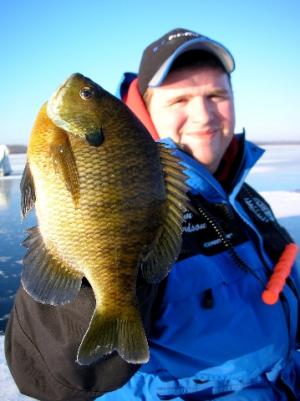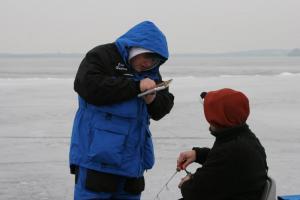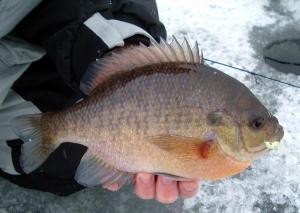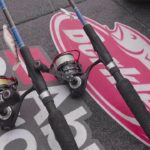Spin Cycle – Eliminate Line Twist for Bluegill Success
It’s the Joker to every bluegill fanatic’s Batman, the Kryptonite to their Superman….that dreaded jig spin. In clear waters, you can look down and see it rotating…big as life…spinning like the second hand of a track coach’s stopwatch. And, for some reason, bluegills have a hard time eating a jig that’s spinning at the end of a line. That wouldn’t be a big deal if it didn’t seem like everything an ice angler does makes the jig spin a little bit more. What’s a poor bluegill-crazed icehead to do? Well, take heart hardwater fans, there is hope.
Eliminating Jig Spin to Put More Bluegills on the Ice
 It’s the Joker to every bluegill fanatic’s Batman, the Kryptonite to their Superman….that dreaded jig spin. In clear waters, you can look down and see it rotating…big as life…spinning like the second hand of a track coach’s stopwatch. And, for some reason, bluegills have a hard time eating a jig that’s spinning at the end of a line. That wouldn’t be a big deal if it didn’t seem like everything an ice angler does makes the jig spin a little bit more. What’s a poor bluegill-crazed icehead to do? Well, take heart hardwater fans, there is hope. Here are some tricks of the trade that the best of the best employ to get that jig to stand stalk-still. It’s up to you now to try them, combine them as necessary, and decide which ones work best for you.
It’s the Joker to every bluegill fanatic’s Batman, the Kryptonite to their Superman….that dreaded jig spin. In clear waters, you can look down and see it rotating…big as life…spinning like the second hand of a track coach’s stopwatch. And, for some reason, bluegills have a hard time eating a jig that’s spinning at the end of a line. That wouldn’t be a big deal if it didn’t seem like everything an ice angler does makes the jig spin a little bit more. What’s a poor bluegill-crazed icehead to do? Well, take heart hardwater fans, there is hope. Here are some tricks of the trade that the best of the best employ to get that jig to stand stalk-still. It’s up to you now to try them, combine them as necessary, and decide which ones work best for you.
Line stretching
Line stretching is one of the easiest things you can do to help prevent jig spin. No matter how hard you might try, if you’re using a spinning reel, eventually you will accumulate some line twist on the spool. Make it a habit to stretch out the first few couple of feet every time you bring your jig up. For such a simple procedure, it can make a huge impact on your presentation. Simply open the bail, strip off a foot or two of line, and close the bail. Starting at the tip of the rod, grasp the line firmly in your right hand and pinch the line between your thumb and index finger of the left hand. It’s also not a bad idea to lubricate the thumb and index finger with a little saliva. Now slide your left hand down the line, stretching as you go. Do this in short six inch chunks, then reposition the right hand 6 inches down the line and repeat these steps until all the line between the rod tip and the jig has been stretched.
A REEL drag!
Of course, the less twist you put into your line, the less line stretching you’ll have to do and the less jig spin you’ll have. With that in mind, one of the quickest ways to put a TON of line twist on your spool is to reel in line as a fish is taking out drag. Basically, it’s fishing’s version of a pioneer’s spinning wheel, because, mechanically, it’s a very similar process. Obviously, since reducing or eliminating line twist is the name of this game, this is something that should never be done. For many anglers, this goes without saying, but I’m amazed every year at the number of anglers I see cranking away on the reel as a fish is pulling line out the other direction…totally oblivious to the twist they’re putting in their line. Long story short, DON’T DO IT!
Line/jig balance
Coils in your line can also cause jig spin, so it’s important that the line (and in turn, the rod itself) be balanced to the jig. When balance between the jig and line is achieved, the line will hang straight and taut under the weight of the jig. A jig that is fished on a taut, balanced line will fall straight down the water column, whereas a jig that falls on an un-balanced, coiled line will spiral all the way down…much as if it were descending a spiral staircase. With coiled line, once the jig arrives at its destination it will start to unwind all the twist that was just put in the line as it spiraled downward, which sometimes can take several minutes depending on how deep it is being fished.
 Oftentimes bluegill fisherman will downsize jigs in an attempt to trigger finicky fish. The only problem with this is that sometimes they don’t downsize the line to match. A small light jig will have a hard time straightening out the heavier line, so coils result. If the line /jig balance is not maintained, rather than triggering fish with a smaller jig, all the fish in the vicinity are now pushed into a very negative state due to the spin of the jig, which is exactly the opposite of the intention.
Oftentimes bluegill fisherman will downsize jigs in an attempt to trigger finicky fish. The only problem with this is that sometimes they don’t downsize the line to match. A small light jig will have a hard time straightening out the heavier line, so coils result. If the line /jig balance is not maintained, rather than triggering fish with a smaller jig, all the fish in the vicinity are now pushed into a very negative state due to the spin of the jig, which is exactly the opposite of the intention.
Proper threading of baits and plastic ane how bait is put on the hook of a jig can also drastically affect the tendency of a jig to spin, particularly when artificial plastics are used. In the case of plastics, the tail will act as a rudder. That’s why it’s essential that plastics be threaded straight on the hook of the jig. Offsetting the plastic, even slightly, to one side or the other can make a jig spin like a top. Sometimes even though the plastic tail appears to be properly aligned, a quick drop down the hole proves otherwise. A good way to combat this is to check the action of a jig before sending it the rest of the way down. A short stop at the hole and a few quick jigs should make it obvious whether or not the jig will spin. If it does, bring it back up, re-adjust, re-check and repeat until the jigs tracks true. This quick check should be done each and every time the jig is lowered down the hole.
While not as drastic as plastics, live bait can also influence jig spin. Depending on jig style, size and jigging style, sometimes two euro-larvae on a hook are what it takes to prevent spin, sometimes it’s 3. Sometimes T-bone hooking a waxworm spins less than one threaded on the hook. Again, experimentation is called for and a few quick “test jigs” in the hole before dropping the jig down to the fish, will ensure that the fish are seeing as little spin as possible once the jig is in front of them.
“The Pound”
For those unfamiliar with it, “the pound” is the term Dave Genz coined for the jigging motion he uses. This technique keeps the jig in constant motion, and gives a nice kick to plastic tails and an irresistible undulation to live baits. But it does one other thing that is every bit as important. “The pound” also keeps the jig from spinning. Many bluegill fishermen use this technique so much that the palsy like quiver in their jigging hand that creates this jig action, happens almost subconsciously as soon as they grasp a jigging rod. Some experimentation may be necessary as to how fast and how big or small to make the jigging strokes for this technique in order to prevent jig spin, but once that amplitude and frequency sweet spot is found stick with it. “Pounding” your jig is also an effective bite detection method. The jig will be felt at the bottom of every stroke of this technique. To the angler’s hand it will feel like a tiny bounce-bounce-bounce-bounce-bounce-bounce every time the jig hits the bottom of the stroke. When a fish takes the jig into its mouth, that bounce stops is no longer transmitted up the line to the fisherman. That’s the cue to set the hook!
Alternative Reels
Sometimes equipment changes can also help to eliminate jig spin. For many years now, practitioners of the technique called “tightlining” have used small plastic reels to prevent jig spin. For this technique, which originated in Michigan, taut uncoiled line is essential. Some refer to these reels as “Schooley” reels and they’re the same colorful plastic reels you typically see mounted to fiberglass rods of the same name. The advantages of these reels is that they have a larger diameter spool than most spinning reels, so they are a lot less likely to leave coils in the line. As we already know from earlier, coil-free line equates to spin-free jigs. Some anglers even take this one step further by “backing” the reel, or filling most of the reel with junk mono or other heavy line in order to increase the effective diameter of the spool, which makes it even harder for coiling to occur. Once the reel is filled with backing, a short segment of line balanced to the jig is tied on as a leader, of sorts, and in turn, the jig is tied to that. As a side note, backing is also a dynamite way to reduce coiling and jig spin on spinning reels, too.
The biggest disadvantage of using one of these small reels is that they essentially have no drag. They have a spring-loaded pressure plate, but all it basically does is prevents the reel from free spooling. For bluegills, this usually isn’t an issue, but if you happen to tie into a feisty bass or a pike decides to take a bite, chances are pretty good that the jig will be lost. With that being said, enough folks believe that the advantages of using these reels far outweigh the disadvantages and use them almost religiously.
A fairly recent development in the world of alternative reels is the use of fly reels. With enough backing, a fly reel offers all the advantages of a Schooley reel as far as coiling and jig spin are concerned. But, a fly reel also has the added benefit of offering a few more options for a drag of one sort or another. Typically the fly reels with the best drags tend to be considerably more expensive than the ones with lesser “clicker” drags, but more and more people serious about catching big bluegills are giving them a try.
Superlines
The creation of superlines has been one of the most exciting breakthroughs to hit the fishing industry in recent years. These high-tech fishing lines offer amazing strength, zero stretch and previously unheard of sensitivity. While originally designed for open water use, superlines also have something to offer the ice-time bluegill fanatic, too. Much to our delight, superlines also resist coiling and line twist, which means we can load up our favorite spinning reel with a spool of superline and virtually forget about jig spin. One line that has become VERY popular with wintertime panfisherman is Berkley’s Fireline Crystal product. It’s the only superline that is almost clear under water, and is offered in the smaller weights that bluegill fanatics prefer to use. While virtually clear, Fireline Crystal is not invisible underwater, and for especially clear water this can be an issue for some anglers. A short fluorocarbon leader tied into the tip of the Fireline with a double surgeon’s knot makes the presentation acceptable to even the most finicky bluegill.
 Try it for yourself and see!
Try it for yourself and see!
A spinning jig is definitely a no-no when chasing winter- time gills. The big bluegills have grown smart enough to know not to eat anything that spins, so to really catch the biggest of the big in any body of water, eliminating the spin in your jig is essential. These are some time-tested and true techniques for doing just that. It’s now up to you to try each of these techniques and decide what works best for you. Maybe one technique or the other will solve all your jig spin problems, or maybe it takes a combination of techniques. Whatever the answer is, take the time to figure it out and you won’t believe how much more effective you’ll become at icing the big boys. Catching big fish consistently is all about details, and jig spin is one detail that the folks who consistently catch big bluegills have got figured out. Tight lines!





